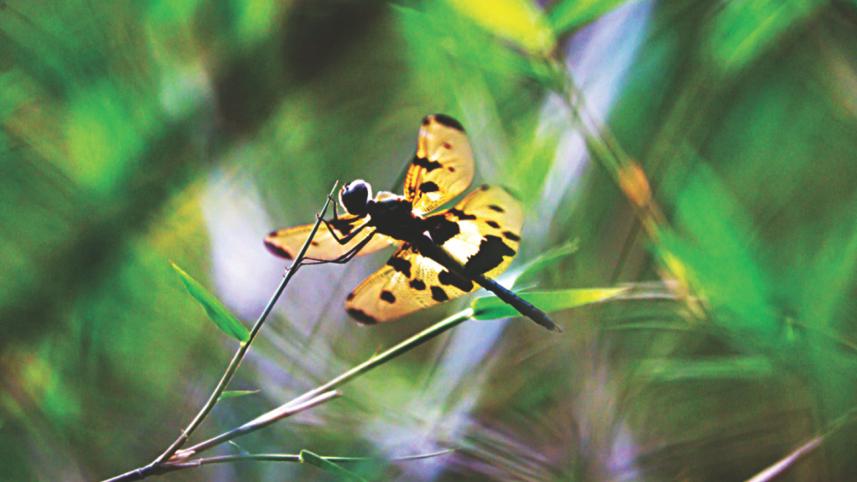The Amazing Dragonfly

What is the world's deadliest predator? You might be surprised at the answer. It is not the tiger, lion, shark or even the falcon. If you measure “deadly” by success in catching prey, dragonflies (foring) are the champions. They catch 95% of all prey they target, compared to 50% by the shark or 25% by the lion. What do they eat? Mostly mosquitoes, flies, bees, other tiny insects, but sometimes even butterflies.
The versatile dragonfly can be found in all continents except Antarctica. There are about 5000 species of dragonflies in the world. They were not always so small. Fossils show that millions of years ago, some dragonflies had wingspans of 30 inches!
Satyajit Ray immortalized the dragonfly's grace in the famous foring sequence of the movie Pather Panchali. I have spent delightful time observing them around water's edge where they fly from one stalk of grass to another. Their wings are extended horizontally whether they are resting or flying. Sometimes two dragonflies fly together during mating, joined in a loop.
The dragonfly's life starts as an egg. The mother can lay 1500 eggs at a time. Baby dragonflies, which live underwater, are called nymphs. They are similar to adult dragonflies but lack wings and reproductive capacity. Most of the dragonfly's life is spent as a nymph – up to several years. While underwater, nymphs eat smaller insects such as mosquito larva or even smaller nymphs. Close to maturity, they spend several weeks with bodies underwater and heads emerged, so they can adapt to breathing in the air. Then they take to flight. This part of their life is shorter and lasts weeks, not years.
In the 1920s, American agricultural scientists, using airplanes to study the aerial movement of insects, found dragonflies flying at 7000 feet altitude. More recently scientists have discovered that some dragonfly species migrate in their short flying career. Millions of dragonflies which arrive in the Maldives annually come from southern India on their way to Africa, it is thought. They possibly cover 10,000 km in their journey. In America, scientists who attached tiny radio gear on the underside of these insects found they can fly up to 100 miles in one day. About 50 species of dragonflies are migratory. Their migration patterns – including flyways - are similar to that of migratory birds, but with one exception: the migration is one-way. We have much to learn about dragonfly migration. For example, we do not know why they migrate and what their migration mechanism is.
Of course, dragonflies are not the only insects that migrate. For example, monarch butterflies and locusts are migratory.
For me the most fascinating aspect of dragonflies is their hunting skill. Their large, powerful, wide-angle eyes and fast flight make them deadly hunters. Their visual neurons bypass the brain and instruct their wings to move instantaneously whenever they see moving prey, giving them lightning quick reflexes. Their long hairy legs help them hold on to their victim. But being the deadliest predators does not save them from becoming prey. Sometimes at twilight you might see a crowd of dragonflies over a field. Watch for birds such as drongos (fingey), ashy woodswallows (ababil) or swifts (batashi) to swoop in and carry them away to be eaten! Such is the way of our world.
www.facebook.com/tangents.ikabir



 For all latest news, follow The Daily Star's Google News channel.
For all latest news, follow The Daily Star's Google News channel.
Comments